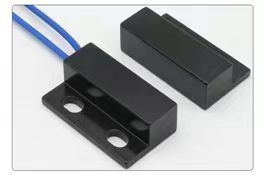ມ່ານທາງອາກາດ, often known as air doors, play a significant role in maintaining indoor environmental conditions and enhancing energy efficiency in different facilities, and they are already becoming a popular solution across various facilities worldwide. But the air curtain is already working even when the door is closed, so sometimes when it require to save energy,then the door sensor is required. ໃນບົດຄວາມນີ້, I will introduce the different types,installation, and main functions of the door sensor, it can help you maximize the effectiveness of your air curtain setup.
What are Door Sensors:
ປົກກະຕິ, a door sensor is a device used to identify and respond to the door’s movements – opening and closing. Despite their apparent simplicity, door sensors incorporate intricate technologies, predominantly magnetism, infrared or mechanical methodologies, which help them perform effectively. As a door swings or slides open, the sensor perceives the movement and triggers a corresponding action – in the context of air curtains, it signals the air curtain to activate.
Door Sensors: The Heart of Air Curtains: Door sensors breathe life into the automated operations of air curtains. On detecting an open door, they instantaneously activate the air curtain. The curtain then propels a powerful stream of air, creating a virtual barrier against outdoor elements, while simultaneously preserving the indoor environment. This seamless interaction between door sensors and air curtains ensures the air curtain functions only when absolutely necessary, marking a significant stride towards enhancing the system’s energy efficiency.
Three types of Door Sensors in Air Curtains:
Magnetic Door Switch: Normally you need to mount this magnetic switch in cabinet door so that the two parts are in contact with each other when the door is closed.

Infrared Door Sensors: These sensors is triggered by a moving object like a person walking through the doorway

Mechanical Door Sensors: These are physically affixed to the door, and the door’s mechanical action, i.e., its opening or closing, actuates the sensor. it works with almost any type of door but used most often on a hinge-style door that swings open and shut

The Door Sensor Advantage in Air Curtains:
Incorporating door sensors in air curtains boosts the system’s energy efficiency by guaranteeing operation only during essential moments, such as when the door is open. This intelligent automation eliminates wasteful energy consumption, augments the performance of the air curtain by assuring prompt responsiveness to door movements, and offers a superior convenience quotient, as it does away with the need for manual operation.
Installation of a Door Sensor for an Air Curtain:
The installation process of a door sensor for an air curtain usually involves carefully mounting the sensor onto the door or the door frame, establishing a connection to the air curtain control system, and calibrating it accurately. Strict adherence to the manufacturer’s instructions or seeking the expertise of a professional is highly recommended to guarantee a correct and effective installation.

ສະຫຼຸບ: Door sensors, despite their modest size, pack a powerful punch in the realm of air curtain technology. Their role in optimizing energy efficiency and enhancing the performance of air curtains is pivotal. A thorough understanding of their functionality, coupled with their correct installation, can lead to a significant improvement in the operational efficiency of your air curtain, ensuring a comfortable and efficient indoor environment.
You also can contact cdairtech engineer with your door type, then we can provide the solution for the door sensor of air curtain



